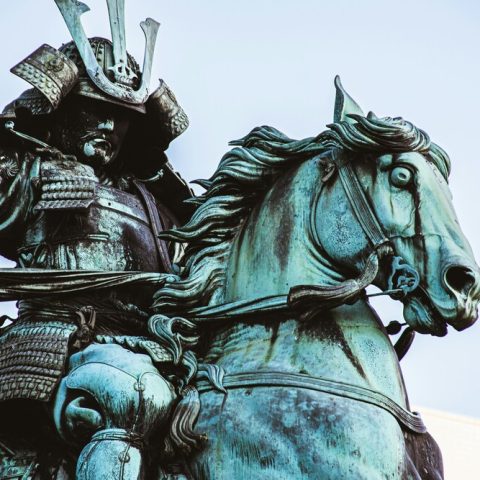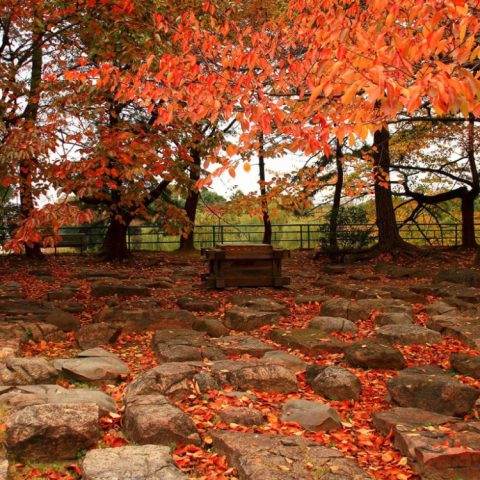
Connecting with Japan’s samurai past through the Owari region in the center of Japan will inspire history buffs and those interested in the Edo era. Beyond that, you can delight your palette with a taste of the local culture through their regional food.
On the three-day Samurai and Timber tour in Aichi and Gifu, you can discover artistry, history, and imagine the military might of centuries past… But for foodies like us, another huge attraction is the delicious tastes of Gujo Hachiman, Inuyama, and Nagoya.

Handmade Soba Lunch/Photo by John Asano
The area around Gujo Hachiman is known for growing buckwheat for making soba noodles and a key element is the clear, quality water flowing down through the mountains. Nothing tastes quite as good as homemade noodles. We had refreshing zaru soba (noodles served chilled with a dipping sauce).

Sake Ice Cream/Photo by Lauren Shannon
There are many sweets and snacks around town but one of our favorites was this sake (rice wine) ice cream sold at a local bottle shop in town. This adult dessert doesn’t disappoint and it kept us coming back for more.

Hoba Miso Beef/Photo by John Asano
For dinner in Gujo Hachiman, we tried something a little bit more substantial and tried a local favorite, the hoba miso beef. This marbled beef dish that you grill tableside on a hoba (Japanese Magnolia) leaf with the classic central Japan red miso (fermented soy paste) and onions gave us the strength and stamina to dance the night away during the famous Odori summer dance festival. Moisture from the food prevents the leaf from burning, and the fragrance of the leaf and the aroma of baking miso blend perfectly. Red miso has a delicious level of umami that complemented the regional Hida beef perfectly!
Day two of the tour took us to another castle town, Inuyama. Nestled below Japan‘s oldest privately owned, famous fortress, the streets were pleasantly packed with shops, restaurants, and street food stalls. We had a chance to try a few local specialties here.

Local Monaka in Inuyama/Photo by Lauren Shannon
Shaped like the castle above us on the hill were these delicious monaka filled with red bean paste surrounded by a crunchy wafer that tastes a lot like a thin ice cream cone. The shop that sells this is charmingly old and this sweet bite was great, so boxes of these would also make a wonderful gift to share with others after your trip.

Grilled Goheimochi/Photo by Lauren Shannon
We already mentioned the rich red miso, popular in this central region. But this time we got to try it on the famous grilled rice dumplings called Goheimochi! Savory, soft, and rich… this was one of our favorite bites of the day! Goheimochi date back to the Edo era, when people working in the mountains stuck rice on pieces of wood, grilled them, and ate them with miso when drinking sake. People also carried them to eat for lunch. In the autumn, this humble dish is also quite festive. They are made and eaten to thank the gods after harvest when all the family members gather or when guests are visiting.

Tea and Dengaku kushi/Photo by Lauren Shannon
We had a real feast for the eyes as well as the stomach. This tea set included different skewers of grilled tofu with seven different sauces and condiments. It was a beautiful dish and tasted even better than it looked. One of our favorites was the sweet and sour Ume pickled plum sauce and shiso herb leaf on the far right. It was wonderful to have so many different varieties in one set! And of course, the green tea was a perfect complement.

Cute Kakigori/Photo by Lauren Shannon
Since this was more like a street food tour with local bites we couldn’t skip this adorable kakigori, shaved ice. Flavorful and surprisingly fluffy, this sweet critter was almost too cute to eat. But we were super glad that we tried it because the flavors were as good as or better than the adorable design! Although that’s definitely hard to believe.

Local Nagoya Noodles/Photo by Lauren Shannon
The last day of the tour took us to the regional powerhouse city Nagoya. At this stop, we had a fantastically filling lunch of kishimen. Characterized by long, flat, and wide noodles with rough edges this was another fulfilling dish of yumminess. We tried the summer version with sliced sudachi, a lime-like citrus that brought out so many interesting elements in the broth.
All in all, we enjoy the three towns and you can read more about our experience here but in addition to sightseeing and connecting with the historical past, we truly enjoyed tasting the regional cuisine! It’s too hard to pick a favorite dish after just one taste so we will have to go back and try again! Can’t wait to return and make more delicious memories.
For information about the tour and to book your own historical and culinary adventure use this link. Highly recommended.



